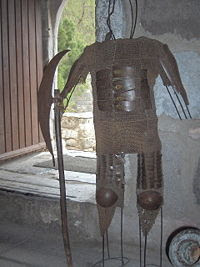
The Ottoman Turks' supply of metal was abundant. They had complex metal arts and crafts. One should not wonder why there is no existing Turkish armors with plates or strips made from buffalo horns. Maybe early on they used buffalo horns but later changed to metals. Thus, there are no existing Ottoman non-metal armors-- so far.
The ottomans had a history of breeding, hunting, and domesticating buffaloes. The population of the Anatolian buffaloes could not be matched by the carabaos of the Philippines. The Ottomans used bull horns in their weaponry specially in making bows. According to some historical accounts, they even melted buffalo horns to be used as ornaments and weapons. They even carved them to make utensils, jewelry boxes, decors, buttons, etc.
When the Ottomans started using metals for their armors, they must have reused the chips and strips of buffalo horns from their old armors. That is a plausible reason why there are no existing Ottoman buffalo horn armors. Some people think that since there are Moro armors made of buffalo horns, the said armors are indeed of Mindanaon origin as if early water buffaloes or carabaos were of distinct Philippine or Mindanaoan breed.
Carabaos are not endemic to the Philippines. Genetically, they can be traced to the wild water buffaloes of India. The Madjapahit Hindus must have brought the cattle with them. Ibn Batuta, a 14th-century Moroccan explorer, wrote about the systematic transportation of cattle in Asia and India. Carabaos must have come directly from Java.
The only bovine that is endemic to the Philippines is the dwarf tamaraw. It can only be found in Mindoro, which is not in Mindanao. Besides, their horns are too small to be considered for armors. When the early Filipinos started domesticating carabaos, they were mainly for farming and milking. Until now, slaughtering a carabao is extremely rare in The Philippines.
The limited population of the domesticated Philippine carabaos also suggests that there is no way their horns could be used in armors that needed pairs and pairs of horns. It also shows that there was no systematic mass breeding or hunting then. If there was, there should have been a lot of wild and leashed carabaos in the Islands before the Spanish came. Historical accounts by Spanish chroniclers wrote about carabaos as farmers' "beasts of burden." They were already domesticated for farm work not for their horns.
Limited supply does not mean more demand. I don't wonder why I only see bull horns used as hilts or handles of bladed weapons by the lumads of Mindanao, Visayans, and Tagalogs. Carabaos are just useful in Philippine traditional economy when they are alive not dead. I don't think slaughtering them for their horns is a tradition among the people in rural Philippines.

The existing Moro armors made of buffalo horns are in good condition. Their gold okir designs are thick and complex. Even the chain linking was obviously not simple and old. They mean that the said armors are not as ancient as the metal armors of the Ottomans. I believe that those buffalo horn armors were from Borneo, which has a tradition of hunting and slaughtering buffaloes for meat, hide, and horns. They are definitely of Turkish influence, even though horns were used.
Until now, there are even water buffalo parade and racing in Malaysia and Indonesia. Some Bornean ethnolinguistic groups still use buffalo heads as economic status symbol. Unlike Borneo, Sulu has no carabao culture. It is not even known for rice farming where carabaos are useful. There is no specific breed of buffaloes in Sulu, and it is not known as the place for hunting wild buffaloes.
Philipine carabaos must have come directly from Madjapahit Java. They were transported by the Hindus to Caraga region, then to Visayas, and then Luzon, the rice granary of the Philippines, where the population of domesticated carabaos is a lot. Also, lumads of Mindanao, Visayans, and Tagalogs have folk tales involving carabao. I don't think Muslims of Mindanao have one. I am still researching. So far, I have found none.
After centuries of domestication and mutation, the horns of the Philippine carabaos changed. They are not as long and wide as the Malaysian buffaloes that still exist today. The horns of Bornean buffaloes which are definitely enough to make armors also suggest that they were once wild, and being hunted and slaughtered for the use of their horns, besides meat and hide.



|